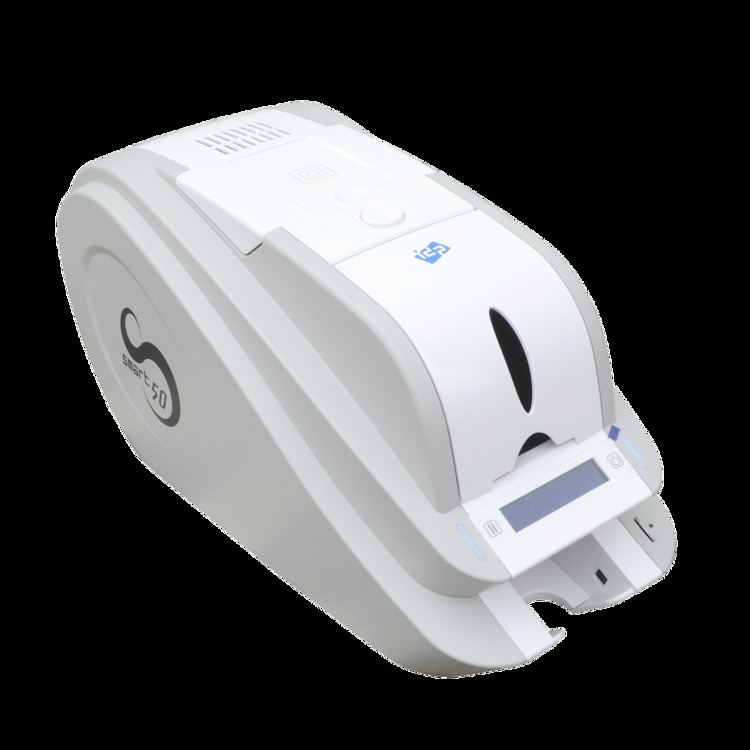 | ||
A card printer is an electronic desktop printer with single card feeders which print and personalize plastic cards. In this respect they differ from, for example, label printers which have a continuous supply feed. Card dimensions are usually 85.60 × 53.98 mm, standardized under ISO/IEC 7810 as ID-1. This format is also used in EC-cards, telephone cards, European Union driver's licenses and health insurance cards. This is commonly known as the bank card format. Card printers are controlled by corresponding printer drivers or by means of a specific programming language. Generally card printers are designed with laminating, striping, and punching functions, and use desktop or web-based software. The hardware features of a card printer differentiate a card printer from the more traditional printers, as ID cards are usually made of PVC plastic and require laminating and punching. Different card printers can accept different card thickness and dimensions.
Contents
Process
The principle is the same for practically all card printers: the plastic card is passed through a thermal print head at the same time as a color ribbon. The color from the ribbon is transferred onto the card through the heat given out from the print head. The standard performance for card printing is 300 dpi (300 dots per inch, equivalent to 11.8 dots per mm). There are different printing processes, which vary in their detail:
Common printing problems
Many printing problems are caused by physical defects in the card material itself, such as deformation or warping of the card that is fed into the machine in the first place. Printing irregularities can also result from chip or antenna embedding that alters the thickness of the plastic and interferes with the printer's effectiveness. Other issues are often caused by operator errors, such as users attempting to feed non-compatible cards into the card printer, while other printing defects may result from environmental abnormalities such as dirt or contaminants on the card or in the printer.
Card printer types
Broadly speaking, there are three main types of card printers available. These types refer to the printing method of which the card printer prints onto the card, they are:
Encoding Techniques
Different ID Card Printers use different encoding techniques to facilitate disparate business environments and to support security initiatives. Known encoding techniques are:
Software
There are basically two categories of card printer software: desktop-based, and web-based (online). The biggest difference between the two is whether or not a customer has a printer on their network that is capable of printing identification cards. If a business already owns an ID card printer, then a desktop-based badge maker is probably suitable for their needs. Typically, large organizations who have high employee turnover will have their own printer. A desktop-based badge maker is also required if a company needs their IDs make instantly. An example of this is the private construction site that has restricted access. However, if a company does not already have a local (or network) printer that has the features they need, then the web-based option is a perhaps a more affordable solution. The web-based solution is good for small businesses that don't anticipate a lot of rapid growth, or organizations who either can't afford a card printer, or don't have the resources to learn how to set up and use one. Generally speaking, desktop-based solutions involve software, a database (or spreadsheet) and can be installed on a single computer or network.
Other options
Alongside the basic function of printing cards, card printers can also read and encode magnetic stripes as well as contact and contact free RFID chip cards (smart cards). Thus card printers enable the encoding of plastic cards both visually and logically. Plastic cards can also be laminated after printing. Plastic cards are laminated after printing to achieve a considerable increase in durability and a greater degree of counterfeit prevention. Some card printers come with an option to print both sides at the same time, which cuts down the time taken to print and less margin of error. In such printers one side of id card is printed and then the card is flipped in the flip station and other side is printed.
Applications
Alongside the traditional uses in time attendance and access control (in particular with photo personalization), countless other applications have been found for plastic cards, e.g. for personalized customer and members’ cards, for sports ticketing and in local public transport systems for the production of season tickets, for the production of school and college identity cards as well as for the production of national ID cards.
